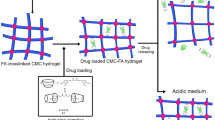Abstract
In this study, we fabricated and characterized nanometric chitosan (Cs)/laponite (La) nanocomposite nanogels for controlled drug delivery applications. Cs and Cs/La nanocomposite nanogels were formed by ionic gelation method using tripolyphosphate. The release of honey as a model drug was monitored using a blood glucose meter. The results of dynamic light scattering and field emission scanning electron microscopy demonstrated that in the wet state, the mean particle size of nanogels were 133 nm and 118 nm for Cs nanogels and Cs/La nanocomposite nanogels, moderately reducing to 32 nm and 95 nm at dried state, respectively. X-ray diffraction analysis confirmed exfoliated morphology for nanocomposite nanogels. Although honey loading increased the size of the nanogels, it had no effect on the morphology of nanocomposite nanogels. The loading efficiency and loading capacity of encapsulation decreased in nanocomposite nanogels. The honey release profile of nanocomposite nanogels began with a burst release, and showed lower values compared to Cs nanogels during the first hour. Our results corroborated to the higher cross-linking density and barrier effect of La in nanocomposite nanogels.
Graphic abstract










Similar content being viewed by others
References
De Pinho Neves AL, Milioli CC, Müller L, Riella HG, Kuhnen NC, Stulzer HK (2014) Factorial design as tool in chitosan nanoparticles development by ionic gelation technique. Colloid Surf A 445:34–39. https://doi.org/10.1016/j.colsurfa.2013.12.058
Hassani S, Laouini A, Fessi H, Charcosset C (2015) Preparation of chitosan–TPP nanoparticles using microengineered membranes—effect of parameters and encapsulation of tacrine. Colloid Surf A 482:34–43. https://doi.org/10.1016/j.colsurfa.2015.04.006
Agnihotri SA, Mallikarjuna NN, Aminabhavi TM (2004) Recent advances on chitosan-based micro- and nanoparticles in drug delivery. J Control Release 100(1):5–28. https://doi.org/10.1016/j.jconrel.2004.08.010
Fan W, Yan W, Xu Z, Ni H (2012) Formation mechanism of monodisperse, low molecular weight chitosan nanoparticles by ionic gelation technique. Colloid Surf B 90:21–27. https://doi.org/10.1016/j.colsurfb.2011.09.042
Hu B, Pan C, Sun Y, Hou Z, Ye H, Zeng X (2008) Optimization of fabrication parameters to produce chitosan-tripolyphosphate nanoparticles for delivery of tea catechins. J Agric Food Chem 56(16):7451–7458. https://doi.org/10.1021/jf801111c
Dong Y, Ng WK, Shen S, Kim S, Tan RB (2013) Scalable ionic gelation synthesis of chitosan nanoparticles for drug delivery in static mixers. Carbohydr Polym 94(2):940–945. https://doi.org/10.1016/j.carbpol.2013.02.013
Li J, Huang Q (2012) Rheological properties of chitosan–tripolyphosphate complexes: from suspensions to microgels. Carbohydr Polym 87(2):1670–1677. https://doi.org/10.1016/j.carbpol.2011.09.074
Fernandez-Urrusuno R, Calvo P, Remuñán-López C, Vila-Jato JL, MaJ A (1999) Enhancement of nasal absorption of insulin using chitosan nanoparticles. Pharm Res 16(10):1576–1581. https://doi.org/10.1023/A:1018908705446
Viseras C, Cerezo P, Sanchez R, Salcedo I, Aguzzi C (2010) Current challenges in clay minerals for drug delivery. Appl Clay Sci 48(3):291–295. https://doi.org/10.1016/j.clay.2010.01.007
Unsoy G, Khodadust R, Yalcin S, Mutlu P, Gunduz U (2014) Synthesis of doxorubicin loaded magnetic chitosan nanoparticles for ph responsive targeted drug delivery. Eur J Pharm Sci 62:243–250. https://doi.org/10.1016/j.ejps.2014.05.021
Huang H-Y, Shieh Y-T, Shih C-M, Twu Y-K (2010) Magnetic chitosan/iron (ii, iii) oxide nanoparticles prepared by spray-drying. Carbohydr Polym 81(4):906–910. https://doi.org/10.1016/j.carbpol.2010.04.003
Mahdavinia GR, Soleymani M, Etemadi H, Sabzi M, Atlasi Z (2018) Model protein BSA adsorption onto novel magnetic chitosan/PVA/laponite RD hydrogel nanocomposite beads. Int J Biol Macromol 107:719–729. https://doi.org/10.1016/j.ijbiomac.2017.09.042
Raut SY, Gahane A, Joshi MB, Kalthur G, Mutalik S (2019) Nanocomposite clay-polymer microbeads for oral controlled drug delivery: development and in vitro and in vivo evaluations. J Drug Deliv Sci Technol 51:234–243. https://doi.org/10.1016/j.jddst.2019.03.001
Yang H, Hua S, Wang W, Wang A (2011) Composite hydrogel beads based on chitosan and laponite: preparation, swelling, and drug release behaviour. Iran Polym J 20(6):479–490
Batista T, Chiorcea-Paquim A-M, Brett AMO, Schmitt CC, Neumann MG (2011) Laponite RD/polystyrenesulfonate nanocomposites obtained by photopolymerization. Appl Clay Sci 53(1):27–32. https://doi.org/10.1016/j.clay.2011.04.007
Fan Q, Shan D, Xue H, He Y, Cosnier S (2007) Amperometric phenol biosensor based on laponite clay-chitosan nanocomposite matrix. Biosens Bioelectron 22(6):816–821. https://doi.org/10.1016/j.bios.2006.03.002
Ordikhani F, Dehghani M, Simchi A (2015) Antibiotic-loaded chitosan-Laponite films for local drug delivery by titanium implants: cell proliferation and drug release studies. J Mater Sci Mater Med 26(12):269. https://doi.org/10.1007/s10856-015-5606-0
Li X, Liu A, Ye R, Wang Y, Wang W (2015) Fabrication of gelatin–laponite composite films: effect of the concentration of laponite on physical properties and the freshness of meat during storage. Food Hydrocol 44:390–398. https://doi.org/10.1016/j.foodhyd.2014.10.014
Li P, Kim NH, Hui D, Rhee KY, Lee JH (2009) Improved mechanical and swelling behavior of the composite hydrogels prepared by ionic monomer and acid-activated laponite. Appl Clay Sci 46(4):414–417. https://doi.org/10.1016/j.clay.2009.10.007
Yuan Z, Fan Q, Dai X, Zhao C, Lv A, Zhang J et al (2014) Cross-linkage effect of cellulose/laponite hybrids in aqueous dispersions and solid films. Carbohydr Polym 102:431–437. https://doi.org/10.1016/j.carbpol.2013.11.051
Gaware SA, Rokade KA, Kale SN (2019) Silica-chitosan nanocomposite mediated pH-sensitive drug delivery. J Drug Deliv Sci Technol 49:345–351. https://doi.org/10.1016/j.jddst.2018.11.022
Shu XZ, Zhu KJ (2002) The influence of multivalent phosphate structure on the properties of ionically cross-linked chitosan films for controlled drug release. Eur J Pharm Biopharm 54(2):235–243. https://doi.org/10.1016/S0939-6411(02)00052-8
Chen RH, Tsaih ML (1998) Effect of temperature on the intrinsic viscosity and conformation of chitosans in dilute HCl solution. Int J Biol Macromol 23(2):135–141. https://doi.org/10.1016/S0141-8130(98)00036-1
Acknowledgements
The authors wish to thank Tarbiat Modares University and the Iran Nanotechnology Initiative Council (INIC) for their supports.
Author information
Authors and Affiliations
Corresponding author
Ethics declarations
Conflict of interest
The authors declare that they have no conflict of interest.
Additional information
Publisher's Note
Springer Nature remains neutral with regard to jurisdictional claims in published maps and institutional affiliations.
Rights and permissions
About this article
Cite this article
Nikfarjam, M., Kokabi, M. Chitosan/laponite nanocomposite nanogels as a potential drug delivery system. Polym. Bull. 78, 4593–4607 (2021). https://doi.org/10.1007/s00289-020-03335-9
Received:
Revised:
Accepted:
Published:
Issue Date:
DOI: https://doi.org/10.1007/s00289-020-03335-9




